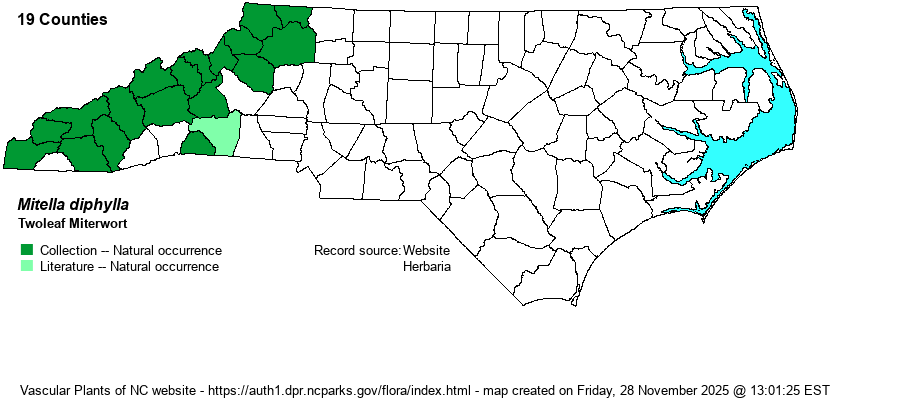| Author | L. | |
| Distribution | Essentially throughout the Mountains, though several well-worked counties along the SC border lack specimens. Not found in the Piedmont, unless just at the edge of the Blue Ridge Escarpment.
This is a Northern species, ranging from southern Canada south to northwestern SC and northern AL. It ranges not only through the Appalachians but also ranges well to the south in the Ohio and Tennessee River valleys to northern AR. | |
| Abundance | Fairly common to frequent in the Mountains, though oddly scarce in the "Gorges" area of Transylvania and Henderson counties. Considering the large number of SERNEC specimens and the range over nearly all of the Mountains, the website editors suggest a State Rank of S4. | |
| Habitat | This is a species of rich forests, normally close to seepage. It favors circumneutral soils -- though most Rich Cove Forests occur over such soils. More often than not, some rocks are present in the rich, moist habitat; and it can be found on mossy or other wet banks, near waterfalls, and other damp and rocky places. | |
| Phenology | Blooms from April to June, and fruits shortly after flowering. | |
| Identification | This is a somewhat delicate member of the saxifrage family, with a flowering stalk growing only to about 1-1.5 feet tall. It has a few basal leaves, each on long petioles about 3 inches long, with a mostly 3-5-lobed blade. The blade is about 2-3 inches long and wide, with a serrated margin. Though the leaves might not stand out as being different from some other members of this family or the buttercup family, the flowering stalk will. It contains a single pair of small, opposite, clasping leaves near the top of the stalk; each of these is heavily toothed but barely 1 inch long. The top 6 inches of the stalk is the narrow raceme of beautiful, intricate white flowers. The perhaps 20 flowers have tiny petals that are deeply divided/fringed, though each flower is barely 1/5-inch across. You will need to get on hands and knees to fully appreciate the "lacy" flowers, especially with a close-up photo. But, this flower is indeed a photographer's target when he or she is conducting a wildflower walk in a rich cove forest in the spring season. Thankfully, it is not overly difficult to find, though these slender plants can easily get lost amid the many other more robust and spectacular wildflowers (trilliums, other lilies, etc.) that can be found on such a walk. | |
| Taxonomic Comments | None
| |
| Other Common Name(s) | Bishop's-cap. Also named as Two-leaved Miterwort. | |
| State Rank | S3 [S4] | |
| Global Rank | G5 | |
| State Status | | |
| US Status | | |
| USACE-agcp | FACU link |
| USACE-emp | FACU link |

